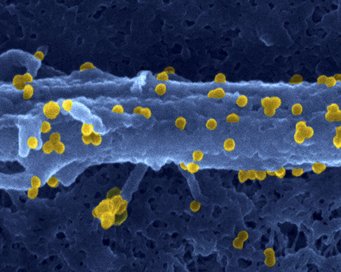An old new weapon against emerging Chikungunya virus
Researchers utilize existing drugs to interfere with host factors required for replication of Chikungunya virus
Since 2013, the mosquito-borne Chikungunya virus has spread rapidly through South America and the Caribbean, and is now threatening Southern Europe and the southern US. It causes flu-like symptoms with fever and joint pains, which in some cases can last for months with occasional fatalities. No treatment or vaccine exists so far - serving as an urgent reminder of just how poorly the time-consuming process of drug development is able to meet the threat posed by newly emerging viruses. Scientists at the Max Planck Institute for Infection Biology in Berlin have now teamed up with colleagues at the Paris-based Institut Pasteur to validate a new approach in the quest for a therapy – combining high-throughput screening for host cell proteins without which the virus cannot replicate, with so-called ‘drug repositioning’, i.e. utilizing an existing drug for new indications. They identified two existing compounds that were effective against the virus in an animal model. Their findings not only bring a Chikungunya treatment within potential reach, but also provide the proof of principle that this approach can be rapidly successful for newly emerging infectious diseases.

The recent Ebola and Zika outbreaks have highlighted how quickly new epidemics can spread in the age of global travel and how helpless modern medicine still is when faced with infectious diseases for which no treatment has been generated. A case in point is Chikungunya fever, which has caused a rising epidemic since it first spread to the Caribbean and Latin America, with more than a million reported cases, and is now poised to spread into the US. While the symptoms are frequently mild, some patients experience crippling arthritic pain that can last for years.
Standard drug development procedures are both expensive and time consuming and the success rates are low. However, emerging epidemics require fast reaction. Professor Thomas F. Meyer with his group at the Max Planck Institute for Infection Biology have now pioneered a new strategy to achieve faster success: In a first step the overall requirement of host factors involved in the infection are identified and then, in a second phase, known drugs effective against the identified host factors are used to block the infection. This rational drug-repositioning strategy could speed up the development process dramatically and allow fast proof of concept.
The principle behind the rational drug-repositioning strategy is the emerging concept that all pathogens depend on proteins produced by the host cell in order to replicate successfully. The challenge lies in the identification of such critical host cell targets. The team found more than 100 host proteins to be required by Chikungunya, by using a robotic system at the MPIIB to knock out each human gene in turn, before infecting the cells with the virus and analysing how well it was able to replicate. Together with the Marc Lecuit's group at Institut Pasteur, who are leading experts on the disease, and collaborators at the Steinbeis Innovation Center and the Charité in Berlin, the University of München and the Institute of Technology in Tartu, Estonia, they next searched for established compounds known to target the most promising host factors before testing them in vitro and in animal models of Chikungunya infection. This process resulted in two drugs, one of them an already widely used antipsychotic, which exhibit therapeutic activity in mice at safe doses, especially when used in combination. Further studies are now required to develop an optimized clinical therapy.
Excitingly, the results also revealed another potential benefit: ‘When we compared the requirement for every human gene in multiple unrelated viruses’ explains Dr Alexander Karlas, a leading virologist at MPIIB. ‘We found that several of the host proteins required by the Chikungunya virus are also required by several other, unrelated viruses as well.’ This potentially opens up a path for developing a range of broadly acting antivirals – which may give a much-needed boost in the battle against emerging viruses.
RZ/TFM
